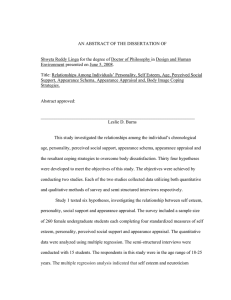Stress - TeacherWeb
advertisement
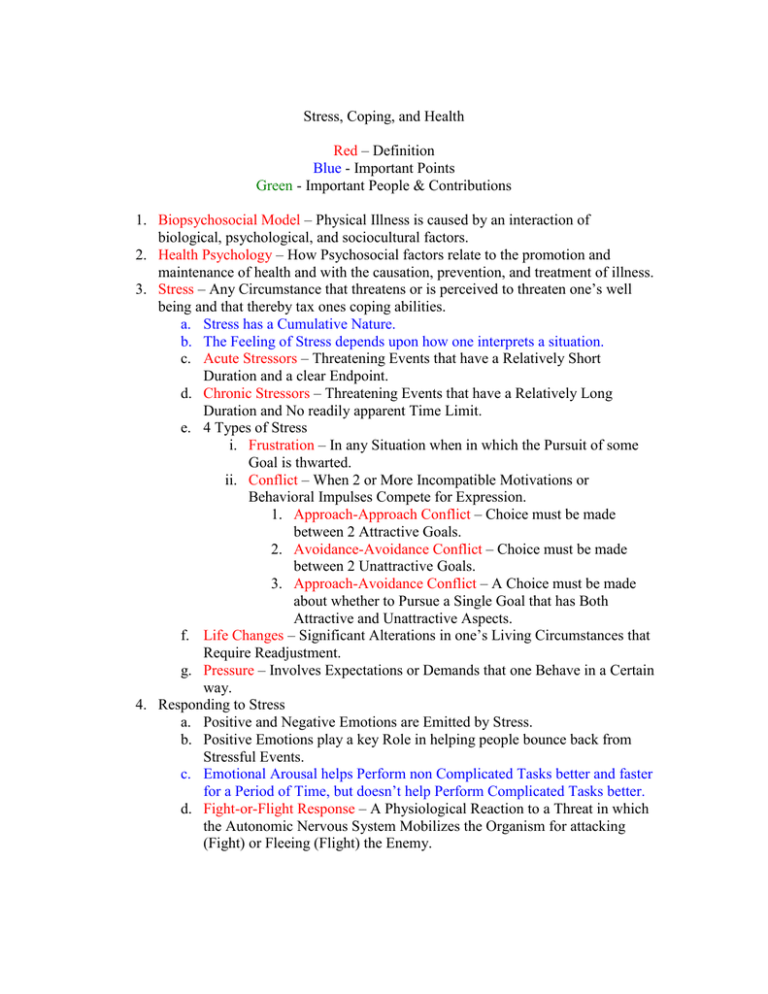
Stress, Coping, and Health Red – Definition Blue - Important Points Green - Important People & Contributions 1. Biopsychosocial Model – Physical Illness is caused by an interaction of biological, psychological, and sociocultural factors. 2. Health Psychology – How Psychosocial factors relate to the promotion and maintenance of health and with the causation, prevention, and treatment of illness. 3. Stress – Any Circumstance that threatens or is perceived to threaten one’s well being and that thereby tax ones coping abilities. a. Stress has a Cumulative Nature. b. The Feeling of Stress depends upon how one interprets a situation. c. Acute Stressors – Threatening Events that have a Relatively Short Duration and a clear Endpoint. d. Chronic Stressors – Threatening Events that have a Relatively Long Duration and No readily apparent Time Limit. e. 4 Types of Stress i. Frustration – In any Situation when in which the Pursuit of some Goal is thwarted. ii. Conflict – When 2 or More Incompatible Motivations or Behavioral Impulses Compete for Expression. 1. Approach-Approach Conflict – Choice must be made between 2 Attractive Goals. 2. Avoidance-Avoidance Conflict – Choice must be made between 2 Unattractive Goals. 3. Approach-Avoidance Conflict – A Choice must be made about whether to Pursue a Single Goal that has Both Attractive and Unattractive Aspects. f. Life Changes – Significant Alterations in one’s Living Circumstances that Require Readjustment. g. Pressure – Involves Expectations or Demands that one Behave in a Certain way. 4. Responding to Stress a. Positive and Negative Emotions are Emitted by Stress. b. Positive Emotions play a key Role in helping people bounce back from Stressful Events. c. Emotional Arousal helps Perform non Complicated Tasks better and faster for a Period of Time, but doesn’t help Perform Complicated Tasks better. d. Fight-or-Flight Response – A Physiological Reaction to a Threat in which the Autonomic Nervous System Mobilizes the Organism for attacking (Fight) or Fleeing (Flight) the Enemy. e. General Adaptation Syndrome – Hans Selye – A Model of the Body’s Stress Response, Consisting of 3 Stages: Alarm, Resistance, and Exhaustion. f. Coping – Active Efforts to Master, Reduce, or Tolerate Demands created by Stress. i. Learned Helplessness – Passive Behavior Produced by Exposure to Unavoidable Aversive Events. ii. Aggression – Behavior that is Intended to Hurt Someone, Verbally or Physically. iii. Catharsis – The Release of Emotional Tension. iv. Internet Addiction – Consists of Spending an Inordinate Amount of Time on the Internet and Inability to Control Online Use. v. Defense Mechanisms – Unconscious Reactions that Protect a Person from Unpleasant Emotions such as Anxiety and Guilt. 1. Most aren’t Beneficial; small Illusions are Beneficial, not Big Illusions. vi. Constructive Coping – Relatively Healthful Efforts that People make to Deal with Stressful Events. 1. Confront Problems Directly. Evaluate your Options so you can Solve your Problems. 2. Appraise your Stress and Coping Resources Reasonably. 3. Learn to Recognize and Inhibit Potentially Disruptive Emotional Resources to Stress. 4. Make Efforts to Endure your Body is not Especially Vulnerable to the Possibility of Damaging Effects of Stress. 5. Stress Effects on Psychological Functioning a. Stress Disrupts Attention and Memory b. Burnout – Physical & Emotional Exhaustion, Cynicism, and a Lowered Sense of Self-efficacy that can be brought on gradually by chronic WorkRelated Stress. c. Stress Can also Promote Personal Growth or Self-Improvement. i. Stress can force People to Develop new Skills, Reevaluate Priorities, Learn New Insights, and Acquire New Strengths. 6. Stress Effects on Physical Health a. Psychosomatic Diseases – Physical Ailments that were to be caused by Stress and other Psychological Factors. b. Type A Personality – Personality with 3 Elements: (1) A Strong Competitive Orientation. (2) Impatience and Time Urgency. (3) Anger and Hostility. c. Type B Personality – Relatively Relaxed, Patient, Easygoing, Amicable Behavior. i. Anger & Hostility in Type A Personalities leads to Heart Disease. d. Immune Response – Body’s Defensive Reaction to Invasion by Bacteria or other Foreign Substances. i. Stress Ages Immune Response Organisms. 7. Factors Moderating Impact of Stress a. Social Support – Various Types of Aid and Succor Provided by Member’s of one’s Social Networks. b. Optimism – A General Tendency to Expect Good Outcomes. c. Conscientiousness – Tendency to have Self- Discipline and be Careful in Actions. 8. Health-Impairing Behavior a. Smoking opens up Possibility for Many Health Problems. i. On Average, Smokers die 13-14 Years before Non-Smokers. b. Bad Diets puts one at More Risk for Heart Disease, Hypertension, etc. c. Lack of Exercise increases Stress, and susceptibility to Cardiovascular Diseases. d. Acquired Immune Deficiency Syndrome (AIDS) – A Disorder in which the Immune System is Gradually Weakened and Eventually Disabled by the Human Immunodeficiency Virus (HIV).
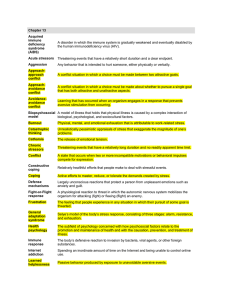
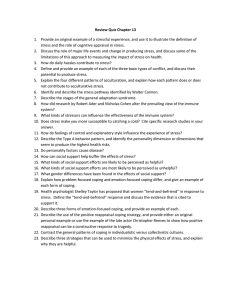
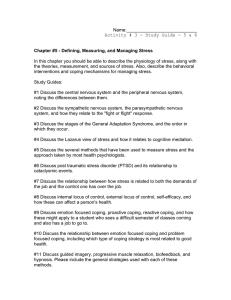
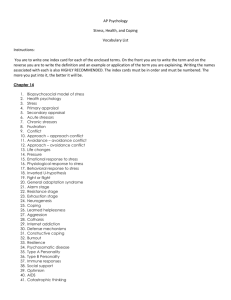

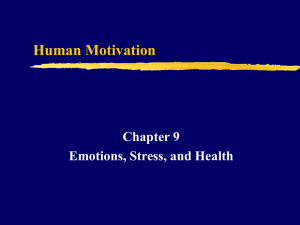
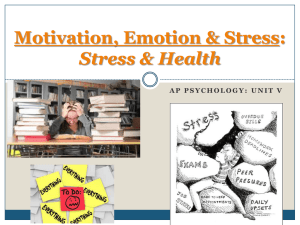
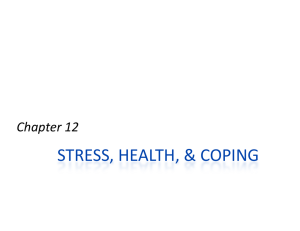
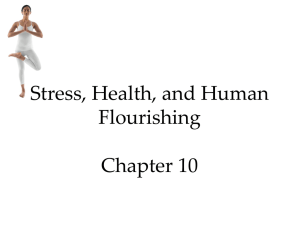
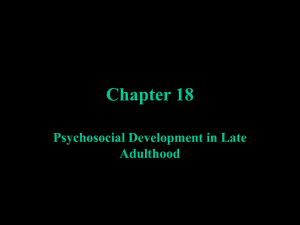
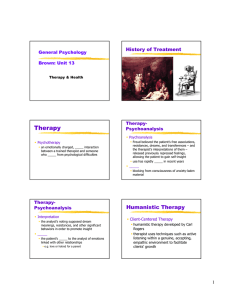
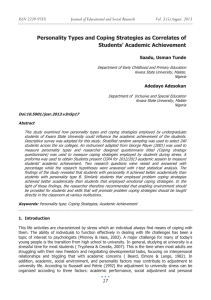
![P1: VENDOR/GCQ/GMF/GCY P2: GCQ/LCR/GDP/ QC: GCQ Journal of Clinical Geropsychology [jcg]](http://s2.studylib.net/store/data/010460962_1-aa85a69fa13ae1e99cfce16e9d93a127-300x300.png)
